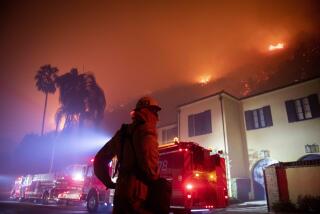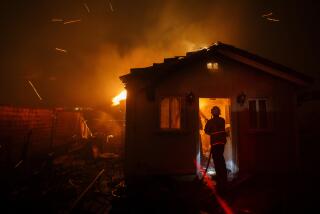Shaky Banks Could Create 2nd Nightmare
WASHINGTON — The savings-and-loan nightmare, which has kept lawmakers awake nights for much of 1990, is back again in a new form: this time as the ghoul that is threatening to devour commercial banks as well.
Realization of this latest crisis fell on this always-nervous city last Tuesday morning, when Comptroller General Charles A. Bowsher told a Senate panel that the federal insurance fund that protects bank depositors for up to $100,000 per account is just a recession away from an S&L-style; wipeout.
Members of Congress had already feared that constituents would go to the polls angry over visions that their children and grandchildren will have to pay for the bailout of the S&Ls; for the next 30 years.
The Federal Savings and Loan Insurance Corp., the fund that insured S&Ls;, went broke, and taxpayers will be spending between $90 billion and $132 billion--not including future interest--to hold depositors harmless.
Having had to authorize one bailout at taxpayer expense, the lawmakers were trembling last week at the very thought of financing another one for bank depositors.
Bowsher was the bearer of bad news, warning that, mainly because of falling real estate prices, banks are beginning to suffer heavy losses, which are threatening to topple some of the good gray institutions and exhaust the Federal Deposit Insurance Corp., the banks’ insurance fund.
“If the sky is not falling, it is shaky,” Sen. Richard T. Shelby (D-Ala.) said warily.
That a second round of bad news could come so quickly is a result of the banking industry’s fast-growing dependence on real estate loans.
Forget the traditional image of bankers as prudent lenders to manufacturers, high-tech firms and department stores. Banks’ biggest business today is making real estate loans--for shopping centers, office buildings, homes and a myriad of developers’ dreams.
Indeed, real estate loans accounted for 23.9% of all bank assets as of June 30--up from only 16.1% just five years ago.
During the 1980s, the banks lost many of their biggest and best customers as giant corporations went out on their own to raise money by selling commercial paper, a type of short-term debt obligation.
“These were the largest borrowers and the best risks for the banks--a lot of volume and very few headaches as far as the loan quality was concerned,” said Ross Waldrop, a financial analyst for the FDIC.
“Bankers had to look elsewhere and commercial real estate was the place to look,” he said.
In 1987, American banking entered a new era: Real estate loans surpassed commercial and industrial lending as the biggest single category of banks’ business. Moreover, the share accounted for by real estate loans has kept growing steadily.
Even with a real estate recession spreading rapidly, real estate loans were still the biggest contributor to the growth in bank assets during this year’s second quarter, climbing by $25.5 billion, more than half the total growth in assets.
The old banking system “was much more stable,” noted Bowsher, head of the General Accounting Office, the investigative arm of Congress. Today’s banks are burdened by “more exotic lending risks,” he said.
Because real estate is volatile--as demonstrated by the troubles of such highly leveraged entrepreneurs as Donald Trump--the bank insurance fund has suddenly become a comparatively weak backstop for depositors’ money.
The fund has shrunk to $13 billion, down from $18 billion two years ago, and FDIC Chairman L. William Seidman foresees another drop of $2 billion or more this year.
Sen. Donald W. Riegle Jr. (D-Mich.), the Banking Committee chairman, fears that the fund may already be insolvent without the regulators knowing it. “We’re down to a paper-thin margin,” Riegle said.
He spoke worriedly of embedded losses--billions of dollars in red ink on real estate projects that currently are worth only a fraction of their former values--that banks have yet to recognize formally on their balance sheets.
The losses could push some banks over the brink, drag the federal insurance fund down and force Congress to spend taxpayers’ money to protect depositors from losses.
The beleaguered fund has survived a sort of rolling recession, absorbing losses from one regional economic slump after another.
In the early 1980s, plunging agriculture prices destroyed some community banks in the Farm Belt. Falling energy prices and a real estate recession wreaked havoc in the Southwest, a painful disturbance that began in mid-decade and is still under way. All but one of the major banks in Texas failed.
In the Northeast, a torrid rise in real estate values has ended, and prices are skidding badly in many localities. The volume of troubled loans--those where repayments are 90 days or more in arrears--is rising rapidly.
The FDIC offered an ominous view of the marketplace in its report on banks’ second-quarter performance: “The real-estate problems of the Northeast have spread to the mid-Atlantic states, and signs of real estate weakness have appeared in several Southeastern states.”
California stands out as a lone point of light in the pattern of gloom. Only 1.44% of the real estate loans of California banks were overdue by 90 days or more during the second quarter--less than half the national rate.
And the performance in California improved from the first quarter, while the national results worsened.
As the real estate recession deepens, fearful regulators and legislators wonder if the badly battered insurance fund can withstand a new onslaught of potential bank failures without collapsing and forcing a bailout by the taxpayers.
“All members of Congress are tremendously nervous about the S&L; crisis,” said Edward Yingling, government affairs director for the American Bankers Assn.
“We have to talk to them very carefully and in a very straightforward manner--to explain that banks are not S&Ls.; Members have a lot of concern, but they don’t feel that the worst case (for banks) is anywhere near the size of the S&L; crisis.” Regulators also are watching banks much more closely than they were monitoring S&Ls; in the salad days, Yingling noted. The agencies now close banks quickly when their capital--the money invested by the owners--is exhausted.
In sharp contrast, hundreds of S&Ls; were permitted to linger in a dying state, with their capital gone, and losses piling up in the billions of dollars.
The GAO identified 35 problem banks that are likely to fail, with potential losses to the fund ranging between $4.4 billion and $6.3 billion. However, none of the nation’s top 20 banks--including the biggest “money center” giants--is in serious danger, Bowsher said.
The GAO chief also told Congress that there is no indication yet that banks are plagued by the rampant fraud and abuse that were hallmarks of many of the most costly S&L; failures.
The banking industry supports a plan to raise $2 billion for the insurance fund by requiring the Federal Reserve Board to pay interest on bank reserves under its control.
But Yingling acknowledges that an aroused Congress may well go even further, giving the regulators a free hand in raising the premiums paid by banks for deposit insurance.
The current premium level is 12 cents for every $100 in deposits, and is scheduled to go to 19.5 cents on Jan. 1. Lawmakers and the Bush Administration are preparing to abolish the 7.5-cent limit on annual premium increases, and permit the FDIC to speed up the increases.
Galvanized by the warnings from the GAO and others, Congress seems determined to give regulators power to collect several billion dollars more to reinforce the fund. The fund will collect $6 billion next year from premiums and interest on investments.
“We must do everything possible to ensure that the banking industry avoids the debacle that consumed the savings and loan industry and is now costing the nation’s taxpayers hundreds of billions of dollars,” Bowsher told the panel. “I hope our message is (clear): we need action.”
Suddenly animated on the issue, legislators hope that a quick effort to bolster the bank fund will save them from having to raise billions of dollars from the taxpayers for another bailout.
“This is not the thrift situation,” said Sen. Alan J. Dixon (D-Ill.), a Senate Banking Committee member. “There is time to act. We can’t afford to let the insurance fund decline.”
If they succeed, the nightmare will go away--they hope. “We don’t want to get caught again,” said Sen. Terry Sanford (D-N.C.).
More to Read
Get the L.A. Times Politics newsletter
Deeply reported insights into legislation, politics and policy from Sacramento, Washington and beyond. In your inbox three times per week.
You may occasionally receive promotional content from the Los Angeles Times.










